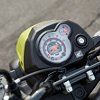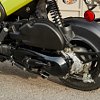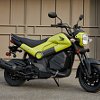Judging a book by its cover in the motorcycle world is common, in part because sometimes it seems easy. But, what if the cover is a little bit confusing?
Hopefully you saw our first-look article about the Navi a few days ago. If not, and you’re too lazy to click on that link, let me summarize quickly: It is a half motorcycle half scooter that features a carbureted 110 cc engine, a CVT-equipped drivetrain, pressed-steel wheels, drum brakes, 15 liters of lockable storage, and four different colorways. Mechanically, the Honda Navi is rudimentary to the extreme, especially considering it’s a new-for-2022 model, and it’s got a price to match: $1,807.

As simple as it is, it’s tricky to classify. The gas tank is just behind the handlebar, like a motorcycle, plus it has footpegs and a rear brake pedal like a motorcycle. Then again, to start it you hold in the brake lever and hit the button, like a scooter. Hmmm. It’s a machine that has the potential to be attractive to many different people, so to make the Navi a little easier to understand here are a couple of descriptions that should help regardless of your motorcycling background.

For the new rider
Plopping down in the saddle, it feels like a cheaper and less aggressive version of its sibling, the Grom. That said, many of the large pieces of the Navi — the engine, transmission, wheels, and many of the underpinnings — are lifted from Honda’s scooter division and, that being the case, riding it is definitely reminiscent of a small-bore scoot. Twist the throttle to go, squeeze or press the brake to stop, and boom you’re a rider. But, even though the riding position is scooter-like, feet pretty far forward and wrists right above your knees, the sensation of controlling the Navi is surprisingly motorcycle-y.

As silly as it sounds, having a seat that slopes up slightly at the front and a gas tank to squeeze between your knees changes the dynamic of the machine. It’s agile and approachable on a scale that few bikes can match, mini or not. The centerstand is so easy to use that I think if you stare at it long enough the bike would lift itself up on its perch. Honda also ran an extra cable from the rear brake pedal to the front brake drum, meaning that soon after the rear brake is engaged the front will follow. That’s not typical for average motorcycles, but it helps add stability and control to a machine that uses such bare-bones technology.

Honda claims 110 miles per gallon, meaning the 0.9-gallon fuel tank might make it a hundred miles, which is fine because realistically the Navi’s radius will be a dozen or so miles from home. It maxes out at about 50 mph, and that might seem slow but if you’re new to riding it’s plenty fast to get yourself in trouble. Fortunately, you won’t be distracted by a dazzling array of displays or features. There’s a speedometer, a fuel gauge and an odometer showing total mileage. What’s coming down the road will be much more interesting to look at, and that’s a good thing.

For the veteran rider
This thing is a hoot. Twist the grip and a feeble little rumble falls out of the pipe, engaging the automatic clutch and scampering forward with just a little bit of urgency. It’s also incredibly light to the touch and predictable to handle, especially at low speeds. Considering it costs $1,800, the Navi feels solid and fully capable of bopping around for as many years as you’d like to keep filling it up with gas or strapping it to the back of an RV. It’s the latest weird little thing from Honda, like the Cub EZ 90 or Motocompo, and there’s a lot of value there.

That’s not to say that it’s premium, though. The weensy wheels and bargain suspension make bumps feel pretty harsh, and even with the nifty linking system the primitive front brake in brand-new condition is barely good enough to quickly stop a bike that weighs as much as a KTM 350 EXC-F. Then there’s the dash, which has a total of three pieces of information and that’s it.

Still, what I said about it feeling like a motorcycle is true. I honestly did not think that having a motorcycle seat and footpegs was going to do anything to keep it from feeling exactly like the scooter it was born from, but boy was I wrong. It creates a much stronger connection between the attitude of the chassis and as a result the sense of control is heightened. Even if I eventually was able to drag the centerstand, I had to ride like kind of an idiot to do it. As long as your only expectation is happy-go-lucky transportation, you’ll probably end up with a huge smile on your face.

The upshot
But, here’s the thing, the Navi’s introduction is not about how it rides as a machine or how many features it promises in the spec sheet. It’s meant to be a small feature itself, fitting into someone’s life to serve a larger purpose. What many of us are wondering (and Honda seems willing to find out) is if the question that the Navi answers is being asked in the U.S. market.

Because let’s face it, this is arguably a bizarre machine to release in the US of A, where luxury doodads and outright power still hold a lot of people’s attention when shopping for a new bike, large or small. Talking to a friend overseas who has intimate knowledge of the Asian motorbike market, I learned just how prevalent this particular 110 cc engine and driveline is, being used in a gaggle of models that Honda has released over the years in Thailand and other adjacent markets. (Perhaps even the Honda Wave that powered a certain Thai-sidecar adventure.)

Interestingly, many of the models have developed into fuel-injected versions, or graduated to a 125 cc variant of a similar powertrain. The Navi was apparently built for the Indian market, then discontinued, seemingly without adopting the larger engines or even disc brakes that often equip the hordes of scooters and motorbikes flowing through streets all over Asia and the subcontinent. It is the lovechild of simplicity and demand, cast off from a pulsating economy of small machines and seeking asylum in the land of bigger-is-better.
It’s amusing to speculate over how we ended up staring into the Navi’s curious and incandescent face. Does Honda simply need to test the theory, every few years, that the growth of cities and the desire for urban mobility has reached a tipping point? Were there 30,000 Navis sitting in a warehouse in India and the North American team didn’t say “not it” fast enough? We may never know. I actually don’t care, and you shouldn’t either.

The fact is, this bike finally represents a real challenge to the ultra-cheap spawn of no-name scooters and mini bikes that have been spreading across the world, with Honda’s reputation and dealer network behind it. The Navi will be as terrific a pit bike for Marc Márquez as it will be an energetic and unintimidating welcome into the world of motorcycling for someone who has never ridden before. Think of it like finding a ten-dollar bill on a sidewalk: Don’t spend too much time questioning the origin or meaning of it, just share it with your friends and have some fun.
| 2022 Honda Navi | |
|---|---|
| Price (MSRP) | $1,807 |
| Engine | 109.2 cc, air-and-fan-cooled, overhead-cam, two-valve single |
|
Transmission, final drive |
CVT and automatic centrifugal dry clutch, belt |
| Claimed horsepower | N/A |
| Claimed torque | N/A |
| Frame | Steel-tube |
| Front suspension | 26.8 mm inverted fork; 3.9 inches of travel |
| Rear suspension | Single shock; 2.8 inches of travel |
| Front brake | Single mechanical 130 mm drum |
| Rear brake | Single mechanical 130 mm drum |
| Rake, trail | 27.5 degrees, 3.2 inches |
| Wheelbase | 50.6 inches |
| Seat height | 30.1 inches |
| Fuel capacity | 0.9 gallons |
| Tires | 90/90-12 front, 90/100-10 rear |
| Claimed weight | 236 pounds |
| Available | January 2022 |
| Warranty | 12 months |
| More info | hondapowersports.com |



















